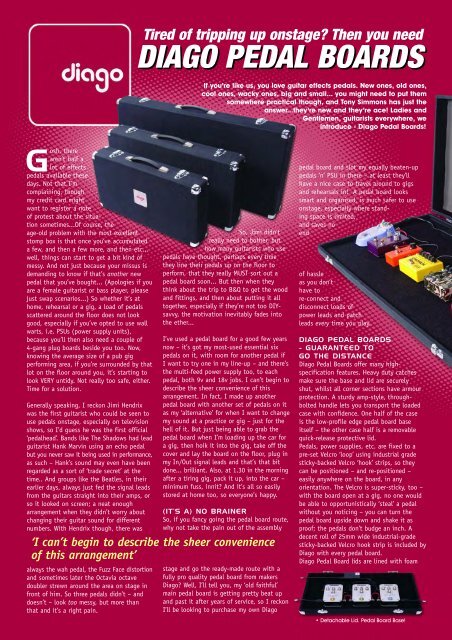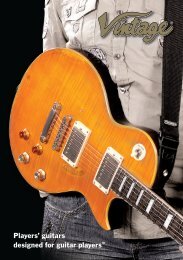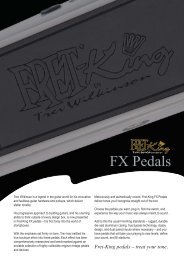GEAR 23_COVER - JHS
GEAR 23_COVER - JHS
GEAR 23_COVER - JHS
Create successful ePaper yourself
Turn your PDF publications into a flip-book with our unique Google optimized e-Paper software.
Tired of tripping up onstage? Then you need<br />
DIAGO PEDAL BOARDS<br />
If you’re like us, you love guitar effects pedals. New ones, old ones,<br />
cool ones, wacky ones, big and small... you might need to put them<br />
somewhere practical though, and Tony Simmons has just the<br />
answer...they’re new and they’re ace! Ladies and<br />
Gentlemen, guitarists everywhere, we<br />
introduce - Diago Pedal Boards!<br />
Gosh, there<br />
aren’t half a<br />
lot of effects<br />
pedals available these<br />
days. Not that I’m<br />
complaining, though<br />
my credit card might<br />
want to register a note<br />
of protest about the situation<br />
sometimes...Of course, the<br />
age-old problem with the most excellent<br />
stomp box is that once you’ve accumulated<br />
a few, and then a few more, and then etc...<br />
well, things can start to get a bit kind of<br />
messy. And not just because your missus is<br />
demanding to know if that’s another new<br />
pedal that you’ve bought... (Apologies if you<br />
are a female guitarist or bass player, please<br />
just swap scenarios...) So whether it’s at<br />
home, rehearsal or a gig, a load of pedals<br />
scattered around the floor does not look<br />
good, especially if you’ve opted to use wall<br />
warts, i.e. PSUs (power supply units),<br />
because you’ll then also need a couple of<br />
4-gang plug boards beside you too. Now,<br />
knowing the average size of a pub gig<br />
performing area, if you’re surrounded by that<br />
lot on the floor around you, it’s starting to<br />
look VERY untidy. Not really too safe, either.<br />
Time for a solution.<br />
Generally speaking, I reckon Jimi Hendrix<br />
was the first guitarist who could be seen to<br />
use pedals onstage, especially on television<br />
shows, so I’d guess he was the first official<br />
‘pedalhead’. Bands like The Shadows had lead<br />
guitarist Hank Marvin using an echo pedal<br />
but you never saw it being used in performance,<br />
as such – Hank’s sound may even have been<br />
regarded as a sort of ‘trade secret’ at the<br />
time.. And groups like the Beatles, in their<br />
earlier days, always just fed the signal leads<br />
from the guitars straight into their amps, or<br />
so it looked on screen; a neat enough<br />
arrangement when they didn’t worry about<br />
changing their guitar sound for different<br />
numbers. With Hendrix though, there was<br />
always the wah pedal, the Fuzz Face distortion<br />
and sometimes later the Octavia octave<br />
doubler strewn around the area on stage in<br />
front of him. So three pedals didn’t – and<br />
doesn’t – look too messy, but more than<br />
that and it’s a right pain.<br />
So, Jimi didn’t<br />
really need to bother, but<br />
how many guitarists who use<br />
pedals have thought, perhaps every time<br />
they line their pedals up on the floor to<br />
perform, that they really MUST sort out a<br />
pedal board soon... But then when they<br />
think about the trip to B&Q to get the wood<br />
and fittings, and then about putting it all<br />
together, especially if they’re not too DIYsavvy,<br />
the motivation inevitably fades into<br />
the ether...<br />
I’ve used a pedal board for a good few years<br />
now – it’s got my most-used essential six<br />
pedals on it, with room for another pedal if<br />
I want to try one in my line-up – and there’s<br />
the multi-feed power supply too, to each<br />
pedal, both 9v and 18v jobs. I can’t begin to<br />
describe the sheer convenience of this<br />
arrangement. In fact, I made up another<br />
pedal board with another set of pedals on it<br />
as my ‘alternative’ for when I want to change<br />
my sound at a practice or gig – just for the<br />
hell of it. But just being able to grab the<br />
pedal board when I’m loading up the car for<br />
a gig, then hoik it into the gig, take off the<br />
cover and lay the board on the floor, plug in<br />
my In/Out signal leads and that’s that bit<br />
done... brilliant. Also, at 1.30 in the morning<br />
after a tiring gig, pack it up, into the car –<br />
minimum fuss, innit? And it’s all so easily<br />
stored at home too, so everyone’s happy.<br />
(IT’S A) NO BRAINER<br />
So, if you fancy going the pedal board route,<br />
why not take the pain out of the assembly<br />
‘I can’t begin to describe the sheer convenience<br />
of this arrangement’<br />
stage and go the ready-made route with a<br />
fully pro quality pedal board from makers<br />
Diago? Well, I’ll tell you, my ‘old faithful’<br />
main pedal board is getting pretty beat up<br />
and past it after years of service, so I reckon<br />
I’ll be looking to purchase my own Diago<br />
pedal board and slot my equally beaten-up<br />
pedals ’n’ PSU in there – at least they’ll<br />
have a nice case to travel around to gigs<br />
and rehearsals in! A pedal board looks<br />
smart and organised, is much safer to use<br />
onstage, especially where standing<br />
space is limited,<br />
and saves no<br />
end<br />
of hassle<br />
as you don’t<br />
have to<br />
re-connect and<br />
disconnect loads of<br />
power leads and patch<br />
leads every time you play.<br />
DIAGO PEDAL BOARDS<br />
- GUARANTEED TO<br />
GO THE DISTANCE<br />
Diago Pedal Boards offer many highspecification<br />
features. Heavy duty catches<br />
make sure the base and lid are securely<br />
shut, whilst all corner sections have armour<br />
protection. A sturdy amp-style, throughbolted<br />
handle lets you transport the loaded<br />
case with confidence. One half of the case<br />
is the low-profile edge pedal board base<br />
itself – the other case half is a removable<br />
quick-release protective lid.<br />
Pedals, power supplies, etc. are fixed to a<br />
pre-set Velcro ‘loop’ using industrial grade<br />
sticky-backed Velcro ‘hook’ strips, so they<br />
can be positioned – and re-positioned –<br />
easily anywhere on the board, in any<br />
orientation. The Velcro is super-sticky, too –<br />
with the board open at a gig, no one would<br />
be able to opportunistically ‘steal’ a pedal<br />
without you noticing – you can turn the<br />
pedal board upside down and shake it as<br />
proof; the pedals don’t budge an inch. A<br />
decent roll of 25mm wide industrial-grade<br />
sticky-backed Velcro hook strip is included by<br />
Diago with every pedal board.<br />
Diago Pedal Board lids are lined with foam<br />
• Detachable Lid. Pedal Board Base!

















